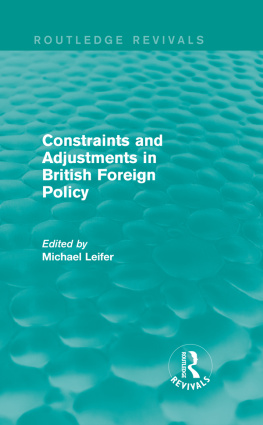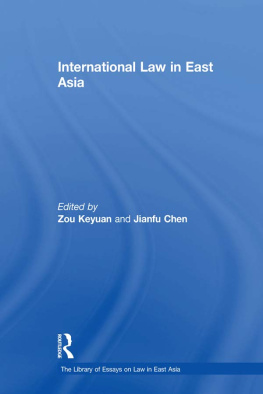Routledge Revivals
ASEAN and the Security of South-East Asia
Problems of internal and external security in South-East Asia have persisted as one set of competing global alignments has been succeeded by another, with major impact on regional relationships. This book, first published in 1989, examines how the states of The Association of South-East Asian Nations (ASEAN) have attempted to confront the problems of regional security. It considers the nature and role of the Association - intended to promote economic growth, social progress and cultural development traces its institutional development from 1967 and identifies a basic structural weakness arising from the differing strategic perspectives held by member governments.
Leifer explores in particular ASEANs response to conflicts over Kampuchea, renamed Cambodia in 1990, which was critical in exposing those differing perspectives and the limited role of a diplomatic community in coping with regional security problems. This comprehensive work will be of particular value to students and academics with an interest in South-East Asian diplomacy, history and regional security.
First published in 1989
by Routledge
This edition first published in 2013 by Routledge
2 Park Square, Milton Park, Abingdon, Oxon, OX14 4RN
Simultaneously published in the USA and Canada
by Routledge
711 Third Avenue, New York, NY 10017
Routledge is an imprint of the Taylor & Francis Group, an informa business
1989 Michael Leifer
All rights reserved. No part of this book may be reprinted or reproduced or utilised in any form or by any electronic, mechanical, or other means, now known or hereafter invented, including photocopying and recording, or in any information storage or retrieval system, without permission in writing from the publishers.
Publishers Note
The publisher has gone to great lengths to ensure the quality of this reprint but points out that some imperfections in the original copies may be apparent.
Disclaimer
The publisher has made every effort to trace copyright holders and welcomes correspondence from those they have been unable to contact.
A Library of Congress record exists under LC control number: 89175813
ISBN 13: 978-0-415-83105-5 (hbk)
ISBN 13: 978-0-203-50450-5 (ebk)
First published 1989
by Routledge
11 New Fetter Lane, London EC4P 4EE
1989 Michael Leifer
Printed in Great Britain by
Billing & Sons Ltd, Worcester
All rights reserved. No part of this book may be reprinted or reproduced or utilized in any form or by any electronic, mechanical, or other means, now known or hereafter invented, including photocopying and recording, or in any information storage or retrieval system, without permission in writing from the publishers.
British Library Cataloguing in Publication Data
Leifer, Michael
ASEAN and the security of South-East
Asia.
1. South-east Asia. National security.
Attitudes of governments
I. Title
327.0959
ISBN 0-415-01008-X
Financial support for travel in the course of preparation of this book has been provided by the Suntory-Toyota International Centre for Economics and Related Disciplines and the Staff Research Fund of the London School of Economics and Political Science. Its completion would not have been possible without the opportunity to spend a year as visiting Professor of Political Science at the National University of Singapore. I thank my colleagues there for their intellectual company. The final draft of the manuscript was typed with care by Margaret Bothwell.
Responsibility for the content and conclusions of this volume rest, of course, exclusively with the author.
The Association of South-East Nations (ASEAN) was established on 8 August 1967 at a meeting in Bangkok between the Foreign Ministers of Indonesia, the Philippines, Singapore and Thailand and the Deputy Prime Minister of Malaysia. Security was uppermost in their minds but not conspicuously addressed. It was contemplated in practical terms as a by-product of institutionalised regional reconciliation. To that end, the five founding governments hoped in time to attract to their ranks all the states of South-East Asia. That goal has not been realised. Indochina lay beyond their prospect until the end of the Vietnam War in 1975, but then fundamental political differences interposed to divide established conservative from successor revolutionary governments. That divide became entrenched as a result of the protracted conflict over Kampuchea (once Cambodia). In the circumstances, Burma deemed it politic to keep its distance from the Association. It was only in January 1984 that membership was augmented by the admission of the Sultanate of Brunei, but without changing ASEANs subregional scope.
ASEANs declared primary goals of promoting economic growth, social progress and cultural development through regional co-operation have been realised also only to a very limited extent. For example, by 1987 trade among the six member states, whose combined populations comprise some 300 million, had amounted to no more than 17 per cent of their total trade. Preferential tariff arrangements had accounted for around 2 per cent of that intra-ASEAN trade. Despite its subregional scope and a modest record of economic co-operation, ASEAN has displayed a quality of political cohesion and a diplomatic accomplishment unanticipated at the outset. The Association has attained a notable international standing in comparison with other Third World regional organisations of larger membership and longer duration. One indication of that standing has been the annual dialogue conducted between ASEANs Foreign Ministers and counterparts from the United States, Japan, Australia, New Zealand, and Canada, as well as a corresponding representative from the European Community. Such dialogues are unique to ASEAN, whose record as a diplomatic community has encouraged regional co-operation in adjacent South Asia which only assumed institutional form in the mid-1980s. Their attraction prompted the Soviet government to seek dialogue partner status in January 1987.
ASEANs international reputation as a diplomatic community derives from an evolving practice of bureaucratic and ministerial consultation. Such a practice has enabled member governments to co-ordinate their regional policies with relative harmony and to some political effect. Regarded widely with unconcealed scepticism at the outset, ASEAN began to attract international attention and respect from 1975 when its members responded to the successes of revolutionary Communism in Indochina by registering a common political identity and purpose. More significantly, since January 1979 the governments of ASEAN have undertaken a sustained diplomatic challenge to Vietnams invasion and occupation of Kampuchea.
ASEANs engagement in the Kampuchean conflict indicates an abiding preoccupation with the problems of regional security. In addressing those problems over Kampuchea, however, ASEAN has exhibited an evident paradox. Whenever governments co-operate with security in mind, it is usual for their collective enterprise to assume some military form. ASEAN, as a corporate entity, has been a notable exception to this rule. Defence co-operation, beyond exchanges of intelligence, does take place among ASEAN states but primarily on a limited bilateral basis and then only outside of the formal institutional structure of the Association. The restricted nature of that co-operation supports the insistence of its governments that their multilateral arrangements have neither embodied the obligations nor assumed the structure of an alliance.



